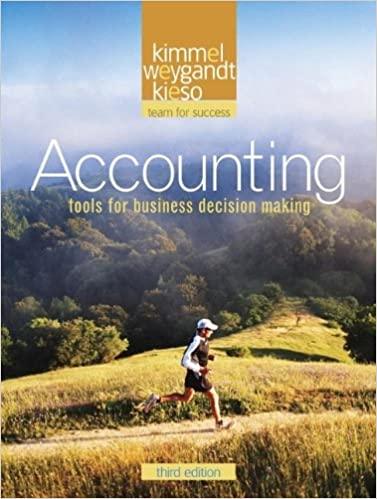E7-7 Analyzing and Interpreting the Financial Statement Effects of FIFO, LIFO, and Weighted Average Cost [LO 7-3) Scoresby Inc. tracks the number of units purchased and sold throughout each year but applies its inventory costing method at the end of the year, as if it uses a periodic inventory system. Assume its accounting records provided the following information at the end of the annual accounting period, December 31. Units 4,000 Unit Cost $20 Transactions a. Inventory, Beginning For the year: b. Purchase, March 5 c. Purchase, September 19 d. Sale, April 15 (sold for $65 per unit) e. Sale, October 31 (sold for $68 per unit) f. Operating expenses (excluding income tax expense), 5610,000 21 23 10,000 6,000 4,400 9,000 Required: 1. Calculate the number and cost of goods available for sale. 2. Calculate the number of units in ending inventory. 3. Compute the cost of ending inventory and cost of goods sold under (a) FIFO. (b) LIFO, and (c) weighted average cost. 4. Prepare an income statement that shows the FIFO method, LIFO method and weighted average method. 6. Which inventory costing method minimizes income taxes? Answer is not complete. Complete this question by entering your answers in the tabs below. Required 1 Required 2 Required 3 Required 4 Required 6 Calculate the number and cost of goods available for sale. Number of Goods Available for Sale Cost of Goods Available for Sale 20.000 units $420,000 s Required Required 2 > E7-7 Analyzing and Interpreting the Financial Statement Effects of FIFO, LIFO, and Weighted Average Cost [LO 7-3] Scoresby Inc. tracks the number of units purchased and sold throughout each year but applies its inventory costing method at the end of the year, as if it uses a periodic inventory system. Assume its accounting records provided the following information at the end of the annual accounting period, December 31 Units 4,000 Unit Cost $20 Transactions a. Inventory, Beginning For the year: b. Purchase, March 5 c. Purchase, September 19 d. Sale, April 15 (sold for $65 per unit) e. Sale, October 31 (sold for $68 per unit) f. Operating expenses (excluding income tax expense), $610,000 21 23 10,000 6,000 4,400 9.000 Required: 1. Calculate the number and cost of goods available for sale. 2. Calculate the number of units in ending inventory 3. Compute the cost of ending inventory and cost of goods sold under (a) FIFO, (b) LIFO, and (c) weighted average cost. 4. Prepare an income statement that shows the FIFO method, LIFO method and weighted average method. 6. Which inventory costing method minimizes income taxes? Answer is not complete. Complete this question by entering your answers in the tabs below. Required 1 Required 2 Required 3 Required 4 Required 6 Calculate the number of units in ending inventory. Ending Inventory 6,600 units E7-7 Analyzing and Interpreting the Financial Statement Effects of FIFO, LIFO, and Weighted Average Cost [LO 7-3] Scoresby Inc. tracks the number of units purchased and sold throughout each year but applies its inventory costing method at the end of the year, as if it uses a periodic Inventory system. Assume its accounting records provided the following information at the end of the annual accounting period, December 31. Units 4,000 Unit Cost $20 Transactions Q. Inventory, Beginning For the year b. Purchase, March 5 c. Purchase, September 19 d. Sale, April 15 (sold for $65 per unit) e. Sale, October 31 (sold for $68 per unit) f. Operating expenses (excluding income tax expense), 5610,000 21 23 10,000 6,000 4,400 9.000 Required: 1. Calculate the number and cost of goods available for sale. 2. Calculate the number of units in ending inventory 3. Compute the cost of ending inventory and cost of goods sold under (a) FIFO. (b) UFO, and (c) weighted average cost. 4. Prepare an income statement that shows the FIFO method, LIFO method and weighted average method. 6. Which inventory costing method minimizes income taxes? Answer is not complete. Complete this question by entering your answers in the tabs below. Required 1 Required 2 Required 3 Required 4 Required 6 Compute the cost of ending inventory and cost of goods sold under (a) FIFO, (b) LIFO, and (c) weighted average cost. Cost of Ending Inventory Cost of Goods Sold FIFO LIFO Weighted Average Cost Check my work mode : This shows what is correct or incorrect for the work you have or the year, as it it uses a periodic inventory system. Assume its accounung recoras providea the following intormation at the e the annual accounting period, December 31 Units 4,000 Unit Cost $20 Transactions a. Inventory, Beginning For the year: b. Purchase, March 5 C. Purchase, September 19 d. Sale, April 15 (sold for $65 per unit) e. Sale, October 31 (sold for $68 per unit) f. Operating expenses (excluding income tax expense), $610,000 21 23 10,000 6,000 4,400 9,000 Required: 1. Calculate the number and cost of goods available for sale. 2. Calculate the number of units in ending inventory. 3. Compute the cost of ending inventory and cost of goods sold under (a) FIFO, (D) LIFO, and (c) weighted average cost. 4. Prepare an income statement that shows the FIFO method, LIFO method and weighted average method. 6. Which inventory costing method minimizes income taxes? % Answer is not complete. Complete this question by entering your answers in the tabs below. Required 1 Required 2 Required 3 Required 4 Required 6 Prepare an income statement that shows the FIFO method, LIFO method and weighted average method. SCORESBY INC. Income Statement For the Year Ended December 31 FIFO LIFO Weighted Average Sales Revenue Cost of Goods Sold Gross Profit Operating Expenses Income (Loss) from Operations










